|
|
|
|
Ekamra Kshetra and the Temple Town Tradition of Odisha: A Historical and Cultural Study
Gayatri Mukherjee 1![]() , Madhumita Roy 2,
Sourovee Dutta 3
, Madhumita Roy 2,
Sourovee Dutta 3
1 Research Scholar, Jadavpur University,
Kolkata, India -700032
2 Professor, Department of Architecture,
Jadavpur University, Kolkata, India -700032
3 Professor, Department of Architecture,
National Institute of Technology Hamirpur (H.P.) India – 177005
|
|
ABSTRACT |
||
|
The evolution
of temple towns in Odisha, particularly focusing on Ekamra Kshetra,
highlights the intricate relationship between urbanization and cultural
heritage. Temples serve as sacred spaces, with their architectural styles
reflecting the region's historical and spiritual significanceThe study traces
the development of Bhubaneswar, known as the 'City of Temples,' from its
ancient roots to its modern urban landscape, emphasizing the impact of urban
growth on its historic character. The research identifies the challenges
posed by rapid urbanization, including the erosion of traditional identities
and the need for sustainable urban planning. By examining the architectural
and cultural transformations within Ekamra Kshetra, the study underscores the
importance of preserving Odisha's rich temple heritage amidst contemporary
development pressures. |
|||
|
Received 10 May 2025 Accepted 12 June 2025 Published 12 August 2025 Corresponding Author Gayatri
Mukherjee, argayatri@gmail.com DOI 10.29121/ijetmr.v12.i8.2025.1659 Funding: This research
received no specific grant from any funding agency in the public, commercial,
or not-for-profit sectors. Copyright: © 2025 The
Author(s). This work is licensed under a Creative Commons
Attribution 4.0 International License. With the
license CC-BY, authors retain the copyright, allowing anyone to download,
reuse, re-print, modify, distribute, and/or copy their contribution. The work
must be properly attributed to its author.
|
|||
|
Keywords: Ekamra Kshetra,
Temple, Odisha, Historical and Cultural |
|||
1. INTRODUCTION
Temple towns are generally developed in a manner that aligns with spiritual aspirations and functional planning based on rituals. In India, historically, many cities have evolved from the religious core and continue to serve as urban areas with religious activities as prime activity. Currently, there is no suitable definition of "temple town" in existing literature. For this research study, a temple town is defined as an urban area that has evolved around one or more temples or temple-related beliefs and continues to attract significant tourist traffic. It is important to note that some cities have their core temples but do not currently have a prominent deity for worship or religious pilgrimage. Additionally, there are cities that have lost their significance as sacred centers and are developing primarily as administrative capitals rather than as destinations for spiritual pilgrimage Rajakumari et al. (2019). This is still evident in city like Bhubaneswar. Conversely, the Lingaraja Temple, Rajarani Temple in Ekamra Khestra, and Jagannath Temple in Puri continue to thrive as sacred tourist destinations.
Urbanization is occurring rapidly in the historic cores of Odisha's old cities, largely due to the absence of strict planning regulations and urban design guidelines. Recent modern developments in these areas are significantly impacting their original character. As a result, the unique identity of these places is gradually disappearing. This research aims to explore the effects of urbanization on these temple towns, reveal the changes in the built environment, and assess the need for improved physical and socio-cultural infrastructure in these heritage zones.
2. Background
The state of Odisha, formerly known as Orissa, is situated on India's eastern coast and is bordered to the east by the Bay of Bengal. Ancient temples, colorful festivals, traditional arts, and a wide variety of fauna may all be found there. It is renowned for its rich cultural legacy, history, and scenic beauty. Odisha's traditional villages have been profoundly impacted by rapid urbanization, which has brought with it both opportunities and challenges. Modern infrastructure is invading historic sites due to urban expansion, endangering their structural integrity and cultural relevance. Land use changes, transportation congestion, and population growth all put strain on historic regions in cities like Puri, Cuttack, and Bhubaneswar. Traditional ways of life are frequently lost as a result of this progress, and intangible cultural heritage is eroded. But, if well managed, urbanization can also have positive effects for conservation efforts, such as better infrastructure and more economic opportunities. To ensure that modernity does not come at the expense of cultural heritage, a balanced strategy integrating sustainable urban design and active community involvement is necessary for the effective preservation of Odisha's historic settlements. The famous historic towns of Odisha was 1)Viraja nagari – Jajpur 2) Ekamra prastha – Bhubaneswar, 3) Sri Purushottam Puri – Puri, 4) Konakama – Konark, 5) Kosala – Sambalpur, 6) Kongoda – Ganjam, 7) Utkala – Cuttack. Mishra (1989)
Figure 1

|
Figure 1 Map to Show the Historic Settlements in Odisha Source Authors |
3. Study Area
The state capital of Odisha,
Bhubaneswar, has been an important center of religion and culture for more than
two millennia. Known as the "City of Temples," Bhubaneswar was
formerly a part of the Kalinga monarchy. Many temples dot the city's landscape,
the most prominent of which is the 11th-century Lingaraja Temple, a masterwork
of Kalinga architecture. The historical significance of the city as a hub for
Hindu worship and innovative architecture is reflected in these temples. Garnayak
(2007)
Figure 2

|
Figure 2 Odisha and
Bhubaneswar |
The legendary Kalinga War occurred in
the region during Ashoka's rule in the third century BCE. Following this event,
Ashoka adopted Buddhism, which had a profound impact on the religious and
cultural fabric of the area. Known as the "Temple City of India,"
Bhubaneswar is a significant religious center that is well-known for its
historic temples and rich cultural legacy. The city is home to more than 700
temples, the most well-known of which is the Lingaraj Temple, which honors Lord
Shiva and features Kalinga architecture. Other important religious locations
are the Rajarani Temple, the Mukteshwar Temple, and the Ananta Vasudeva Temple.
The temples of Bhubaneswar draw both tourists and believers because they
provide a spiritual and architectural window into the past. The city is a major
hub for religious events and pilgrimages because of its unique combination of
spirituality, history, and culture. As a religious hub, Bhubaneswar kept
growing, drawing tourists and academics from various parts of India.
When the city was selected in 1948 to
serve as the capital of the newly created state of Odisha, it experienced a
dramatic metamorphosis in the middle of the 20th century. The new capital was
to be designed by German architect Otto Königsberger, who created a
contemporary urban layout with wide streets, green areas, and administrative
buildings. With this construction, Bhubaneswar officially changed from being a
medieval temple town to an urban planning hub.
Bhubaneswar has seen a rapid increase
in modernization and urbanization in recent years. With the presence of
numerous esteemed establishments like the All-India Institute of Medical
Sciences (AIIMS) and the Indian Institute of Technology (IIT), it has become a
significant center for both education and the economy. The IT industry in the
city has expanded, drawing capital and creating job possibilities. Bhubaneswar
has made progress in the development of its infrastructure, including new
commercial spaces, contemporary residential complexes, and better
transportation networks, in tandem with its economic expansion.
Even with these developments,
Bhubaneswar has been able to maintain its cultural legacy. The city's distinct
fusion of heritage and advancement is highlighted by the presence of historic
temples and contemporary facilities. Bhubaneswar is regarded as one of India's
smart cities today, successfully juggling modern urban development with the
preservation of its rich cultural history. The city is still thriving today.
Figure 3

|
Figure 3 Map of the
City of Bhubaneswar -old and new town; Source: EKAMRA KSHETRA |
4. Bhubaneswar – Historic Group Settlements
Famous for its ancient group settlements, Bhubaneswar has
a rich and varied cultural legacy in places like Dhauli, Khandagiri, Ekamra
Kshetra, and Sisupalgarh. Every one of these locations provides a distinct
window into the rich past and magnificent architecture of Odisha.
Khandagiri: Famous for its rock-cut caves that date back to the first century
BCE, Khandagiri is also known for the nearby Udayagiri hills. King Kharavela of
the Mahameghavahana dynasty ordered the construction of these caverns for Jain monks.
The stunning sculptures and inscriptions in the meticulously carved caves, like
the well-known Rani Gumpha (Queen's Cave), offer insights into the Jain
religion and the sociopolitical context of the time. The area's rich spiritual
and cultural history is attested to by the caverns.
Figure 4

|
Figure 4 Map Showing
the Ancient Group Settlements in Bhubaneswar Source https://www.researchgate.net/publication/325904510_The_Chitrakarini_Temple_of_Bhubaneswar_Odisha_India_An_Investigative_Field_Study |
1) Ekamra
Kshetra: Known for its concentration of
historic temples, Ekamra Kshetra, the old town of Bhubaneswar, has been dubbed
the "City of Temples." The exquisite 11th-century Lingaraja Temple,
devoted to Lord Shiva, is located in this region. The temple complex, with its
soaring spire, elaborate carvings, and expansive courtyard, is a prime example
of Kalinga architecture. Other noteworthy temples in Ekamra Kshetra include the
Rajarani Temple, distinguished by its red and yellow sandstone structure, and
the Mukteswara Temple, renowned for its elaborate carvings and elaborate
archway. Because of its historical significance, this region is a hub for
religious and cultural events, honoring the city's long history. Mishra
(1989)
2) Sisupalgarh:
One of India's biggest and best-preserved ancient fortifications, Sisupalgarh
is an old fortified city that dates back to the third century BCE. A
sophisticated urban colony with thoughtfully designed streets, imposing
entrances, and cutting-edge drainage systems is revealed by archaeological
investigations. The city's rectangular layout and fortified walls were
purposefully created to highlight the engineering prowess and urban planning
abilities of its residents. Sisupalgarh provides an enlightening glimpse into
Odisha's pre-urban history and its importance as a significant political and
cultural hub.
3) Dhauli:
Situated on the banks of the Daya River, Dhauli is a location with significant
religious and historical significance. It is most known for being connected to
the Kalinga War (261 BCE), which turned Emperor Ashoka from a conqueror to a
Buddhist supporter. The Shanti Stupa (Peace Pagoda), built in the 1970s by the
Japan Buddha Sangha and the Kalinga Nippon Buddha Sangha, is a distinguishing
feature of the Dhauli hills. Reflecting Ashoka's adoption of Buddhism, the rock
edicts of Ashoka, written on a rock next to the stupa, promote the values of
dharma (righteousness) and non-violence. Dhauli is still a popular destination
for pilgrims and a representation of harmony and tranquillity.
5. Ekamra Khestra-The historical context
The history of Bhubaneswar begins with the conquest of Kalinga by Ashoka in 261 B.C. Before the 3rd century B.C., the history of Bhubaneswar is not well-documented. However, archaeological findings from the Neolithic, chalcolithic, and early historical periods indicate that humans inhabited this area as early as 2000 B.C. Discoveries of ring stones, microliths, and black-and-red pottery support this assertion. The excavation of Sishupalgarh conducted in 1948 provided significant insights into its chronological framework, indicating a timeline that extends from 300 B.C. to 350 A.D. However, a recent re-evaluation of specific pottery types discovered during these excavations, along with a comparative analysis of similar pottery found in South India, suggests the possibility of revising the earlier date for Sishupalgarh beyond the previously established 300 B.C. The particular type of pottery under consideration is known as black and red ware.
Little is known regarding the ruler of ancient Kalinga during the period of the Asokan conquest. However, it is established that Sishupalgarh served as the ancient capital of the Kalinga dynasty at that time. Following the liberation from Magadhan domination, the Chedi dynasty emerged as the next significant ruling power in ancient Orissa. Kharavela, recognized as the most prominent monarch of the Chedi dynasty, presided over a brief yet impactful reign lasting 13 years, as documented in his Hatigumph inscription located at the Udayagiri caves near Bhubaneswar. Sishupalgarh, along with the nearby historic site of Old Bhubaneswar, likely constituted the primary capital region during the reign of the Chedi dynasty.It is challenging to find evidence regarding rulers following the 1st century B.C. until the emergence of the Sailodbhavas. However, through archaeological findings, it is possible to reconstruct the history of Bhubaneswar during this period. Based on the discovery of sculptures, pottery, coins, and other artifacts, it can be reasonably inferred that post the 1st century B.C., Bhubaneswar was influenced by external powers such as the Kushanas, the Murundas, and the Guptas, in addition to the local vigraha rulers of Toshali.
The golden era of cultural history in this region spans from the late 6th century A.D. to A.D. 1568. During this period, Bhubaneswar was administered by several prominent dynasties, including the Sailodbhavas (A.D. 575 – A.D. 700), the Bhaumakaras (A.D. 736 – A.D. 940), the Suryavamsis (A.D. 1435 – A.D. 1540), and the Chalukyas (A.D. 1559 – A.D. 1568). Subsequently, Orissa lost its independence as administrative control of the coastal district transitioned to the Mughals, the Sultans of Bengal, the Marathas, and ultimately the British, which continued until 1947.In conclusion, it can be observed that although Ekamra Khestra Bhubaneswar diminished in its significance as the capital city after the 1st Century B.C., it subsequently achieved recognition as a prominent Saiva center, evolving into a city renowned for its numerous temples. This transformation established it as a significant pilgrimage destination, a status it continues to uphold in the present day. Concurrently, the establishment of New Bhubaneswar has resulted in its designation as the new capital of the modern state of Odisha.
Figure 5

|
Figure 5 Lingaraja
Temple lithograph by James Fergusson and Thomas Dibdin, in 1847| Columbia
University Source https://puratattva.in/lingaraja-temple-climax-of-the-kalinga-architecture/ |
Ekamra Kshetra encompasses the
historical area of the old city of Bhubaneswar, which serves as the focal point
for temple architecture. This region is recognized as a significant Hindu
pilgrimage site. As per the Anantavasudeva Inscription of
Paramarddi, Ekamra was a sacred area “...adorned
with hundreds of mango-groves, wherein exists a single Devakula [temple] surrounded
by numerous temples.” The 13th-century Ekamra Purana describes a sacred area known as Ekamra Kshetra, which spans a circumference of 10 miles, bordered
by prominent landmarks such as Khandagiri Hills, Kundalesvara Temple, Balhadevi
Temple, and Bahirangesvara Temple, with the Lingaraj Temple positioned at its
center. This sacred Kshetra also
encompasses an inner circle defined by the Meghesvara Temple and Sundaresvara
Temple. The Ekamra Kshetra comprises
45 villages organized into eight sacred precincts, each featuring water bodies,
temples, shrines, tirthas, and ritual procession routes linked to the Lingaraj
Temple. While Lingaraj Temple served as the focal point of Ekamra Kshetra, the historical town of Bhubaneswar oriented towards
the Bindusagar Tank situated in close proximity to the temple. A geomantic
approach was implemented in the town's planning, carefully considering
topography, the location and orientation of water bodies, land use zoning, and
other factors. The overall structure of the town reflects an organic adaptation
of the Mandala concept rather than a strict geometric design. Tanks such as
Bindusagar, Devipadahara Tank, and Kapilesvara Tank are imbued with religious
significance and are regarded as sacred sites.
Ekamra Kshetra, known as the "Temple
City," is remarkable for its concentration of ancient monuments, featuring
around 700 temples that showcase the evolution of Kalinga architecture,
culminating in the renowned Lingaraj Temple. Architectural historian James
Fergusson praised it as "one of the finest examples of a purely Hindu
temple in India." The site also exemplifies meticulous urban planning,
integrating water bodies and a structured road system based on the Mandala
concept. Ekamra Kshetra highlights a blend
of religious traditions, including Brahminical, Buddhist, and Jain systems,
with Brahminical faiths like Saiva, Sakta, and Vaisnava demonstrating
advancements in architecture and urban planning. The temples serve as vital
centers for cultural traditions, rituals, and festivals, aided by the
longstanding Sevayats (Servitors) and their communities surrounding the
temples.
Figure 6
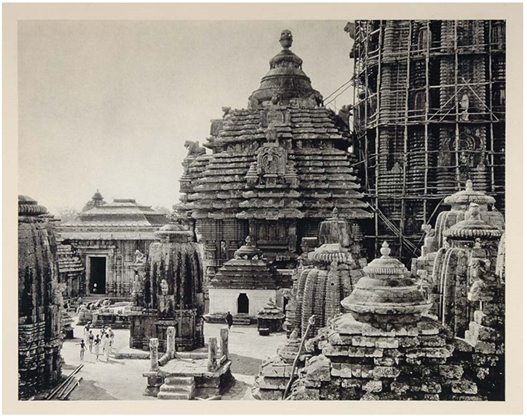
|
Figure 6 Lingaraja Temple by Martin Hurlimann in 1928| Columbia University Source https://puratattva.in/lingaraja-temple-climax-of-the-kalinga-architecture/
|
6. Ekamra Khestra-The historical context
Bhubaneswar, a city renowned for its
rich history and architectural wonders, has undergone several phases of
development, each distinguished by unique group settlements that over the ages
have reflected the cultural, religious, and political significance of the city.
These communities' development can be linked to numerous significant historical
periods:
1) Ancient Period (3rd Century BCE - 1st Century CE)
Sisupalgarh: Dating back to the third
century BCE, Sisupalgarh is one of the oldest known urban settlements in
Bhubaneswar. This fortified city, with its rectangular form, imposing
entrances, and intricate drainage systems, is a prime example of superior urban
design. During the Mahameghavahana dynasty's tenure, archaeological digs have
shown a prosperous metropolis that functioned as a significant political and
cultural center.
2) Early Historic Period (1st Century BCE - 3rd Century CE)
Khandagiri and Udayagiri caverns: In
the first century BCE, King Kharavela ordered the construction of these
rock-cut caverns for Jain monks. The elaborate carvings and inscriptions on the
cave walls offer important insights into the religious and cultural customs of
the era. The intricate sculptures and architectural aspects of the Rani Gumpha,
also known as Queen's Cave, are especially noteworthy.
3) Medieval
Period (7th Century CE - 12th Century CE)
Ekamra Kshetra: Bhubaneswar, and
especially the Ekamra Kshetra region, became an important religious centre in
the Middle Ages. Many temples were built during this time, the most well-known
of which is the 11th-century Lingaraja Temple. The temple complex is a prime
example of the Kalinga architectural style, which is distinguished by tall
spires, fine sculptures, and complex rites. Other noteworthy temples from this
era are the Rajarani Temple, which is distinguished by its distinctive
sandstone structure, and the Mukteswara Temple, which is well-known for its
elaborate arches.
Figure 7
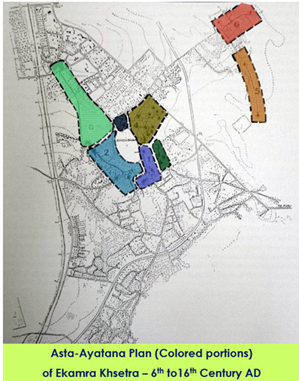
|
Figure 7 Asta Ayatana
Plan |
|
Name
of Ayatana |
Important
Monuments |
|
1st
Ayatana |
Ananta
Vasudeva, Lingaraj, Sahasralinga Tank |
|
2nd
Ayatana |
Papanasini
Kunda, Yameswara, Venu – Kichaka |
|
3rd
Ayatana |
Ganga
Yamuna Kunda, Mukhteswara |
|
4th
Ayatana |
Rajarani,
Kedareswara, Gouri Kunda |
|
5th
Ayatana |
Brahma
Kunda, Brahmeswara |
|
6th
Ayatana |
Megheswara,
Kapalamochaneswara |
|
7th
Ayatana |
Uttareshwara,
Bhimeswara |
|
8th
Ayatana |
Rama
Kunda, Lakshmaneswara |
7. Analysis, Discussions and Findings
Ekamra Kshetra – Development of Astayatan
1) The
Ekamra Kshetra Chronology
The history of the Ekamra Kshetra
neighborhood of Bhubaneswar is extensive, spanning multiple centuries. This
area, which is well-known for having a high concentration of temples, displays
how Odisha's architecture and culture have changed throughout time. This is a
summary of Ekamra Kshetra in chronological order:
Figure 8

|
Figure 8 Ekamra
Kshetra Stage 1 |
2) Early
Historic Period (6th Century CE - 8th Century CE)
·
Important Temple Constructions: In the
seventh and eighth centuries CE, the Mukteswara Temple, which is regarded as a
masterpiece of Odishan architecture, was built. The development of the mature
Kalinga architectural style can be seen in this temple, which features an
outstanding torana (arched entryway) and intricate sculptures.
Figure 9
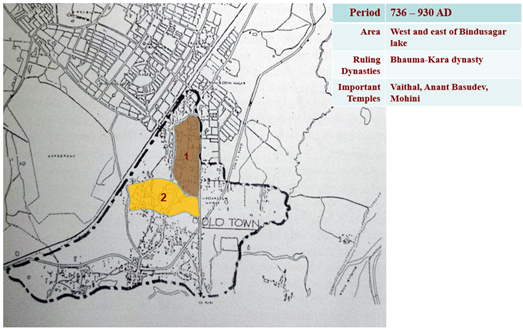
|
Figure 9 Ekamra
Kshetra Stage 2 |
3) Medieval
Period (8th Century CE - 12th Century CE)
·
9th–10th century CE: Several minor
temples are constructed, including the Parsurameswar Temple, which demonstrates
the intricate details of temple building and sculpture as they evolve.
·
11th century CE: Work on the Lingaraja
Temple begins. This is the biggest and most well-known temple in Ekamra
Kshetra. This temple, which honors Lord Shiva, becomes a hub for devotion and
pilgrimage and represents the pinnacle of Kalinga architecture.
·
The Rajarani Temple was constructed in
the twelfth century CE. It is distinct from the other temples in Bhubaneswar
due to its intricate figurative carvings and unusual red and yellow sandstone.
Figure 10
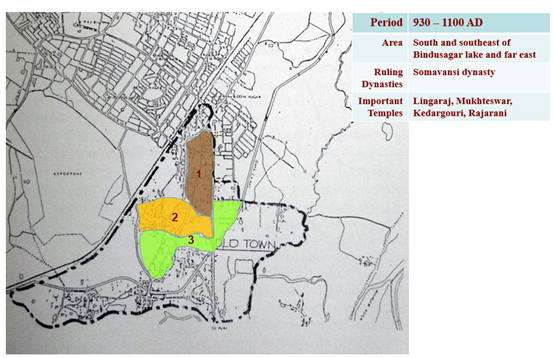
|
Figure 10 Ekamra
Kshetra Stage 3 |
Figure 11
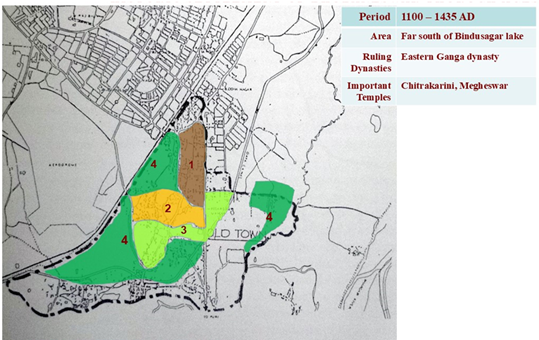
|
Figure 11 Ekamra
Kshetra Stage 4 |
4) Post-Medieval
Period (12th Century CE - 16th Century CE)
Remaining Religious Significance:
Ekamra Kshetra is still very important religiously, even though the number of
new temples being built is decreasing. The temples are still used as active
places of worship, and the region is where older buildings are maintained and
occasionally renovated.
·
Figure 12
Cultural Renaissance: With rituals,
festivals, and customs being actively kept and upheld, the temples of Ekamra
Kshetra are essential to Odisha's cultural renaissance.
Figure 12
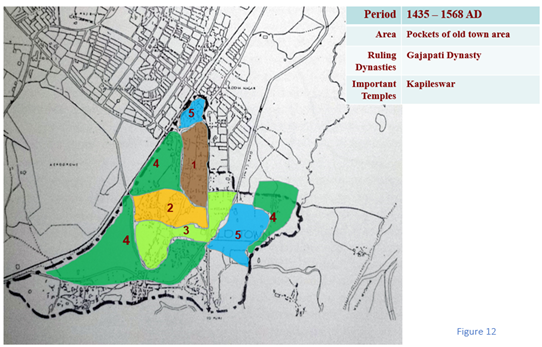
|
Figure 12 Ekamra
Kshetra Stage 5 |
5) Colonial
Period (19th Century CE - Mid-20th Century CE)
·
British Administration: There is very
little direct action in Bhubaneswar, including Ekamra Kshetra, during British
control. Local communities still acknowledge and protect the area's religious
and cultural legacy, nevertheless.
·
Archaeological Interest: Historians and
archaeologists are drawn to the temples, which prompts research and
documentation that serves to conserve and advance knowledge of Odisha's
architectural legacy.
6) Modern
Period (Post-Independence 1947 - Present)
·
1948: The newly constituted state of
Odisha names Bhubaneswar as its capital. Planned urban development is
implemented in the area, fusing contemporary infrastructure with its ancient
landmarks.
·
Conservation Initiatives: With a
greater emphasis on conserving Ekamra Kshetra's historical legacy, conservation
initiatives are being undertaken to preserve the temples' structural integrity
and cultural relevance.
·
Travel and Pilgrimage: Ekamra Kshetra
is becoming a popular travel and pilgrimage site. In order to maintain the
viability of the historic temples and their customs in the face of contemporary
development, the state government and local authorities market the region as a
heritage site.
·
The Smart City effort, which includes
Bhubaneswar, includes goals to improve urban living while honoring and
protecting its historical zones, such as Ekamra Kshetra.
Figure 13
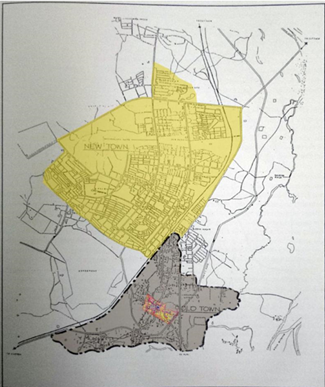
|
Figure 13 Ekamra
Kshetra, Source: Ekamra Heritage report |
8. Development of the New Capital Town of Bhubaneswar
An important period in the history of
Odisha and post-independence urban planning in India was marked by the growth
of the new town of Bhubaneswar in the middle of the 20th century. The necessity
to replace the older, more crowded town of Cuttack with a new capital for the
state of Odisha was the driving force behind this transition.
9. Initial Strategy
and Vision
1948: Following Indian independence,
Odisha needed a new capital large enough to handle contemporary administrative
tasks and allow for further expansion. The historical significance, strategic
position, and potential for growth of Bhubaneswar led to its selection.
Otto Königsberger's Master Plan: The
new town was to be designed by German urban planner and architect Otto
Königsberger. His idea of a contemporary, well-functioning metropolis with an
orderly urban structure was paramount. Wide streets, lots of greenery, and
separate areas for business, residential, administrative, and recreational use
were all included in the concept. The goal of Königsberger's design was to
create an effective, well-structured urban environment by incorporating modern
planning ideas.
Figure 14
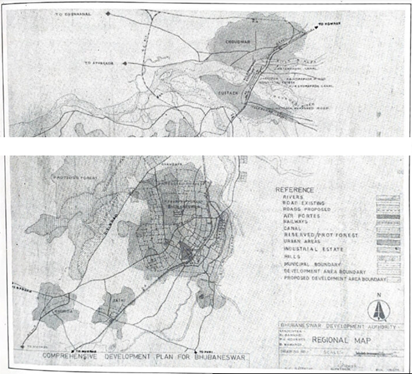
|
Figure 14 Map of Old Bhubaneswar Sourcehttps://questionofcities.org/how-bhubaneswars-master-plan-was-overtaken-by-unsustainable-development/ |
Figure 15
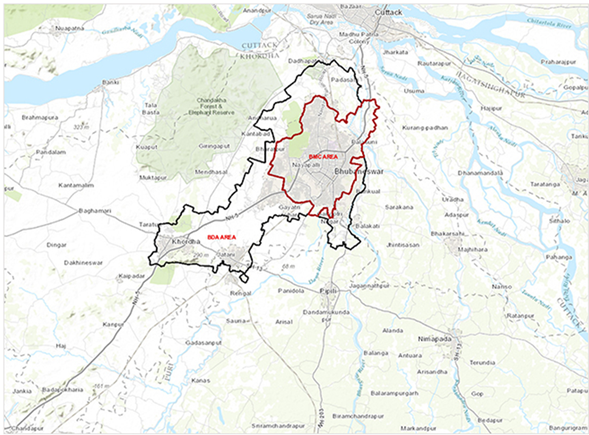
|
Figure 15 Present-day
map of Bhubaneswar |
Figure 16
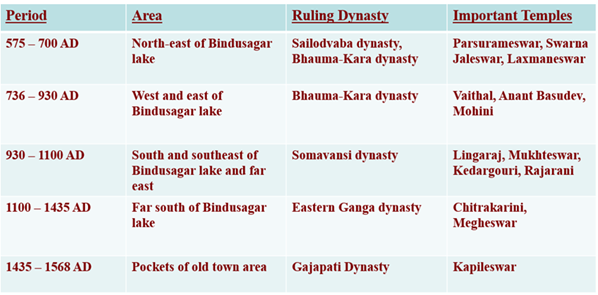
|
Figure 16 Historic
Settlement of Bhubaneswar through the Ages |
10. Important Developmental Stages
1950s: During the first stage of
development, government buildings, housing for government workers, and
necessary infrastructure were built. Some of the first buildings constructed
were the Assembly House, the Secretariat Building, and other administrative
offices. The groundwork for Bhubaneswar's development as an operational state
capital was laid during this time.
1960s–1970s: The city grew as new
public amenities, medical facilities, and educational institutions were built.
During this period, prominent establishments such as the Capital Hospital and
Utkal University were established, which helped Bhubaneswar become a center for
healthcare and education. The creation of residential areas like Saheed Nagar
and Bapuji Nagar gave the expanding population somewhere to live.
1980s–1990s: Bhubaneswar kept
expanding while emphasizing on enhancing connectivity and infrastructure. Major
road, bridge, and public transportation infrastructure projects improved the
city's internal mobility and access to other regions of Odisha. The development
of industrial regions like Mancheswar and Chandaka accelerated employment
creation and economic expansion.
11. The Smart City Initiative in the
Modern Era
From the 2000s to the present:
Bhubaneswar saw a tremendous increase in modernization and urbanization at the
turn of the century. There was a sharp increase in the erection of multiplexes,
malls, and high-rise structures in the city. With the creation of Info city and
other technology parks, the IT industry started to thrive, drawing investments
and generating job possibilities.
In 2015, Bhubaneswar was chosen as
one of the initial 20 Indian cities to be built under the Smart City Mission.
The project sought to improve the efficiency, sustainability, and livability of
the city. A strong public transportation system, sophisticated traffic control,
e-governance services, and the construction of green spaces and public areas
were among the major initiatives.
12. Preservation of Culture and
Heritage
Despite the speed at which
modernization was advancing, Bhubaneswar's rich cultural legacy was preserved.
Initiatives were made to combine cultural conservation with urban growth, and
historic sites such as Ekamra Kshetra were preserved. Bhubaneswar's reputation
as a center of culture was upheld by the city's temples, customary
celebrations, and cultural events.
13. Hub for Research and Education
Prestigious universities like the
National Institute of Science Education and Research (NISER), the All India
Institute of Medical Sciences (AIIMS), and the Indian Institute of Technology
(IIT) Bhubaneswar are located in this educational powerhouse. These
establishments have established the city as a hub for research and higher
education, drawing scholars and students from all around the nation. Going
forward, Bhubaneswar wants to strike a balance between sustainability and
expansion. The improvement of infrastructure, raising living standards, and
encouraging inclusive growth are the main objectives of the city's development
goals. To make Bhubaneswar a model for urban development in India, smart city
initiatives are still evolving.
The evolution of Bhubaneswar from a
medieval temple town to a contemporary metropolis is a prime example of
well-thought-out urban development. The city's journey positions it as a
dynamic, forward-thinking, and energetic metropolitan hub, demonstrating its
ability to embrace modernization while conserving its rich cultural and
historical heritage.
14. Conclusion
The historical context reveals that
Ekamra Khestra, along with nearby sites such as Khandagiri-Udaygiri,
Sishupalgarh, and Dhauli, represents a unique historical heritage of
significant archaeological value. While it continues to be an important Shaiva
pilgrimage center, it has not been a major urban center since the Mauryan
period. With the establishment of the new Bhubaneswar as the capital of Odisha,
the old town has faced increased threats from urbanization, largely due to a
lack of balanced planning for the new city. This lopsided development has been
exacerbated by the low prioritization of the old town area.
The proliferation of diverse sects within Hinduism has led to intricate processes of transformation and adaptation in the cultural landscape. This exceptional sacred landscape persists to the present day, exhibiting a remarkable array of resources that reflect various typologies. The objectives of this research are to examine the evolutionary processes and the dependent variables associated with Ekamrakshetra, situating this analysis within the framework of various historical periods and in relation to the dynamics of urban development and to evaluate how urbanization affects the distinctive characteristics of Ekamra Khestra’s historic urban core. The study aimed to assess the impact of urbanization on the areas surrounding the Ekamra Khestra precinct, which is an urban core rich in cultural and architectural heritage. Additionally, the study sought to examine how these changes impact the cultural and architectural identity of the city. The studies conducted indicate that the increase in population, commercial activities and shifts in land-use patterns are affecting the traditional character of the area. Historic buildings, which were once constructed using locally sourced materials, are increasingly being replaced or modified with modern construction techniques. The spatial layout and street character of the Ekamra Khestra area, once defined by low-rise, traditional buildings, are now being transformed into mixed-use or fully commercial spaces. Unfortunately, there has been little to no effort to conserve the cultural heritage of the city.
CONFLICT OF INTERESTS
None.
ACKNOWLEDGMENTS
None.
REFERENCES
Bhuyan, R. (2017). Evolution of Kalingan Style of Temple—A Study. P: ISSN NO.:
2394-0344.
Chand, S. (2005). Odishan Temple Architecture. Orissa Review, July 2005.
Chandan, S., Pipralia, S., Kumar, A. (2023). The Challenges of Urban Conservation in the Historic City of Puri. Journal of Urban Regeneration and Renewal, 17(1), 105–121.
Das, M. K. B. (2019). History of Odisha (From Earliest Times to 1434 A.D.). DDCE/History
(M.A)/SLM/Paper.
Fergusson, J., & Cie, B.
(1910). History of Indian and Eastern Architecture
(Vol. 2). Journal.
Garnayak, D. B. (2007). Evolution of Temple Architecture in Odisha. Odisha Review, November 2007.
Gupta, D. (2024, April). Heritage Development Plan for the Historic City of Varanasi. Article in Context.
Jha, S. K. (2018). The Chitrakarini Temple of Bhubaneswar (Odisha, India): An Investigative Field Study. Chitrolekha Journal on Art and Design, 2(1). https://doi.org/10.21659/cjad.21.v2n105
Kak, S. (2005). Early Indian Architecture and Art. Migration & Diffusion: An
International Journal, 6(23), 6–27.
Madan, P. (1971). Patterns of Urbanization: Unit 4 Patterns of Urbanization Structure.
Meister, M. W., & Coomaraswamy, A. K. (1988). Early Indian Architecture IV: Huts and Related Temple Types. https://doi.org/10.1086/RESv15n1ms20166783
Mishra, B. (2012). Social Structures in Western Odisha Under the Chauhans.
Mishra, L. K.
(1989). Evolution and Trend of Urbanization in Odisha. Academia.edu.
Mishra, L. K. (2005). Evolution of Temple Architecture in Odisha. Academia.edu.
Mishra, L. K. (2011). Social Formations in Early Historic Odisha. Proceedings of the Indian History Congress, 72(Part I), 60–67. https://doi.org/10.5771/0490-1606-2011-2-67
Mishra, S. (1989). Ekamra Kshetra Heritage Project. INTACH.
Mohanty, L. (2003). Regional Identity of Odisha: Contribution of Studies on Temples. Odisha Review, October 2010.
Parashar, R., & Bandyopadhyay, A. (2016). Temples of Odisha—The Geometry of Plan Form. IJIRST–International Journal for Innovative Research in Science & Technology, 2(10).
Patel, C. B. (2003). Oldest Jagannath Temple of Puri: The Buddhist and Somavamsi connections. Odisha Review, July 2003.
Patra, S. K., & Patra, B. (2004). Archaeology and the Maritime History of Ancient Odisha. Odisha Historical Research Journal, 47(2), 107–118.
Praharaj, M. (2012). Historic Conservation and Sustainability: Case of Bindusagar Lake.
Rai, G. S., & Mahn, C. (2020). History, Memory, and Contestation: Challenges in Preserving Amritsar's Diverse Heritage. In M. Chalana & A. Krishna (Eds.), Heritage Conservation in Postcolonial India: Approaches and Challenges (pp. 13–27). Routledge. https://doi.org/10.4324/9781003109426-9
Rajakumari, M., Kalaiselvi, R., Preethi, K. G., & Tharun Balaji, S. R. (2019). Urban Design and Spatial Layout of Temple and Temple Towns of Tamilnadu-India. International Journal of Innovative Studies in Sciences and Engineering Technology, 5(4).
Sarangi, S. S. (2017). Influence of Vernacular Architecture in Evolution of Temple forms of Odisha. IJIRST–International Journal for Innovative Research in Science & Technology, 4(2).
Sethupathi, M., & Poornima, P. (2020). Conservation of Natural and Heritage Resources in Madurai Region, Tamilnadu, India. Psychology and Education, 57(9), 3608–3615. https://doi.org/10.17762/pae.v57i9.1454
Seymour, S. (1980). The Transformation of a Sacred Town: Bhubaneswar, India. Westview Press.
Sharma, U., Mistry, P., & Prajapati, R. (2019). Revitalization Strategy for Historic Core of Ahmedabad. Journal of Environmental Science and Sustainable Development, 4(2), 45–60. https://doi.org/10.21625/essd.v4i2.555
Sinha, A. (2014). Architectural History in India: A Post-Colonial Perspective. Tekton, 1(1), 32–47.
Sterling, A. (1904). An Account: Geographical, Statistical and Historical of Orissa Proper, or Cuttack. Central Secretariat Library.
|
|
 This work is licensed under a: Creative Commons Attribution 4.0 International License
This work is licensed under a: Creative Commons Attribution 4.0 International License
© IJETMR 2014-2025. All Rights Reserved.


